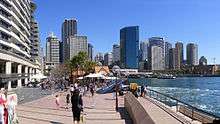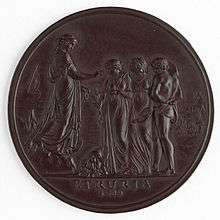Sydney Cove

Sydney Cove is a small bay on the southern shore of Sydney Harbour, one of several harbours in Port Jackson, on the coast of Sydney, New South Wales, Australia.

History
The Native name for what is now known as Sydney Cove was either War-ran, Weé-rong, Warrane or Warrang. [1]

Sydney Cove was named after the British Home Secretary, The 1st Baron Sydney (who was later created The 1st Viscount Sydney in 1789). It was the site chosen by Captain Arthur Phillip, R.N., between 21 and 23 January 1788 for the British penal settlement which is now the city of Sydney, and where possession of New South Wales was formally declared on 26 January (now commemorated as Australia Day).[2] Today, the exact site where the flag was planted is not apparent, as in its place is Circular Quay and buildings of the CBD.
Phillip's instructions were to establish the settlement at Botany Bay, a large bay (further south of Sydney Cove) down the coast. Botany Bay had been discovered by Lieutenant James Cook during his voyage of discovery in 1770, and was recommended by the eminent botanist Sir Joseph Banks, who had accompanied Cook, as a suitable site for a settlement. But Phillip discovered that Botany Bay offered neither a secure anchorage nor a reliable source of fresh water. Sydney Cove offered both of these, being serviced by a freshwater creek which was soon to be known as Tank Stream.[3][4]
It must have been like entering paradise on that summer afternoon when the sea-won convoy passed through the dun and barren headlands into the untouched harbour - the water brilliantly blue, the shores high and wooded without being precipitous, a scattering of islands, sandy beaches, the trees shimmering under the sun.
The site of the settlement was Sydney Cove. It was one of the smaller inlets, chosen because it had fresh water and good anchorage for ships close into the land. The Governor's working party had cleared a camping ground beside the creek, which stole silently along through a very thick wood, the stillness of which had then for the first time since the Creation, been interrupted by the rude sound of the labourer's axe.[5]
Today the Tank Stream is encased in a concrete drain beneath the streets of the central business district [6] and all native bushland has been cleared. The head of the cove is occupied by the Circular Quay ferry terminal. On Bennelong Point at the northern end of the eastern shore of the cove stands the Sydney Opera House. On the western shore is the historic district known as The Rocks.[7]
The Hyundai A-League football team Sydney FC's active supporter group The Cove takes its name from the site.
Sydney Cove Medallion

A sample of the dark grey clay of Sydney Cove was collected by Governor Phillip and given to Sir Joseph Banks, who gave it to the great pottery maker Josiah Wedgwood to test for suitability for making pottery. Wedgwood found it excellent, and made a commemorative medal that became known as the Sydney Cove Medallion.[8][9]
Culture
Sydney Cove is a focal point for community celebrations, due to its central Sydney location between the Sydney Opera House and the Sydney Harbour Bridge. It is one of the main congregation points for Sydney New Year's Eve.
Water Polo by the Sea is held there every year by Australian Water Polo with the Australia men's national water polo team take on the International All Stars.[10]
Sydney FC draw support from right across Sydney, and is one of the most heavily supported clubs in Australia, as they were the only A-League team from Australia's largest city until 2012. The largest supporter group of Sydney FC is known as "The Cove",[11] and are located at the Paddington (northern) end of Sydney Football Stadium in bays 22 – 26. The name came from the original name given to the colonial settlement of Sydney — Sydney Cove.
See also
- D. Manning Richards. Destiny in Sydney: An epic novel of convicts, Aborigines, and Chinese embroiled in the birth of Sydney, Australia. First book in Sydney series. Washington DC: Aries Books, 2012. ISBN 978-0-9845410-0-3
- Sydney punchbowls
References
- ↑ Australian Museum Place Names Chart
- ↑ Discover Sydney: Sydney's European History
- ↑ City of Sydney: The Tank Stream
- ↑ A Day on Sydney Harbour: Sydney Cove
- ↑ Flora Eldershaw; Marjorie Barnard (writing under their joint nom de plume M. Barnard Eldershaw) (1938). Phillip of Australia. Australia: Angus and Robertson. External link in
|title=(help) - ↑ Tank Stream Tour: photographs by Sydney photographer Daniel Boud
- ↑ Sydney Street Directory. Sydney: UBD. 1999. p. 1. ISBN 0-7319-1055-9.
- ↑ Josiah Wedgwood's Sydney Cove Medallion, National Museum of Australia.
- ↑ National Museum of Australia Sydney Cove Medallion from the museum's Collections Search.
- ↑ http://www.waterpolobythesea.com/
- ↑ Huxley, John (2 March 2006). "They're not just dribblers – these Coves are committed". The Sydney Morning Herald. Retrieved 5 August 2014.
Coordinates: 33°51′31″S 151°12′42″E / 33.85861°S 151.21167°E
| Wikimedia Commons has media related to Sydney Cove, New South Wales. |